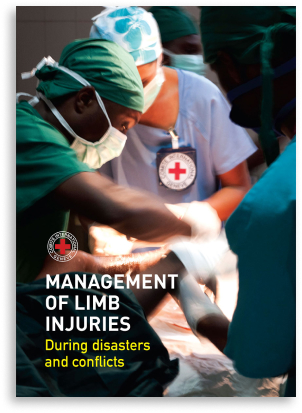Management of Limb Injuries
Management of Limb Injuries

During disasters and conflicts
In disasters, up to 90% of the surgical workload faced by national and international emergency medical teams involves limb injury. The need has never been greater for clear practical guidance for surgical teams to practice safe, effective limb injury care fit for the context of conflict or disaster, and not necessarily what they do in normal daily practice.
The WHO Emergency Medical Team (EMT) Initiative helps countries and NGOs to set up teams that will be able to maintain agreed standards of quality and self-sufficiency, resulting in better patient care. With more teams striving to reach these standards, clear guidance on best practice is needed, particularly for managing patients with limb injuries, which make up the majority of cases.
Read more on the WHO Emergency Medical Teams website.
Content by chapter
-
1. Context
Triage
Phases of disasters
Burden of disease in sudden onset disasters
Earthquakes / Tsunamis / Floods
Healthcare in danger
Patient factors
-
2. Ballistics
Ballistics & Energy
Transfer
Bullet wounds
Blast injuries
Management
Sample content -
3. Logistics, field support and training
Logistics and self-sufficiency
Logistics standards
Training for EMTS
Considerations for training
-
4. Anesthesia and perioperative care
Initial assessment
Pre-operative care
Post-operative care
Anaesthesia
Pain management and patient record
-
5. Damage control surgery and resuscitation
Principles of damage control surgery and resuscitation
Resuscitation and pelvic fractures
Diagnosis and management
Placement of anterior frames for pelvic fractures
-
6. Limb wounds
Wound management
Wound surgery
Wound debridement by layers
Dressings
-
7. Closed fractures
Closed fracture management
Immobilization
After-care and follow up
Removing casts
Traction
Paediatric considerations
Transfers Management of closed fractures with internal fixation
-
8. Open fractures
Wound debridement
Fracture stabilization
External fixation for open fractures
Management of open fractures
-
9. Compartment syndrome and crush syndrome
Compartment syndrome diagnosis
Compartment syndrome treatment
Crush syndrome
Crush syndrome management in SODs
-
10. Amputations
Lower extremity amputations
Specific technical considerations
Upper extremity amputations
Special considerations
Complications of amputation
Key messages regarding amputation
-
11. Burns
Clinical management of burns
Surgical management of burns
Chemical and electrical burns
-
12. Ethics of healthcare in disasters and conflicts
Main ethical theories
Tools to deal with ethical dilemmas
EMT guiding principles
Research ethics in disasters
-
13. Rehabilitation
Acute care treatment
Sub acute treatment
Chronic-long term treatment
Family involvement and equipment
-
Annexes
ICRC ABCD initial assessment
ICRC Burns Overview
ICRC Thromboprophylaxis guideline
ICRC Triage
ICRC Femur Fracture and Traction
An initiative of the AO Foundation and the International Committee of the Red Cross. In collaboration with The World Health Organization EMT Secretariat



